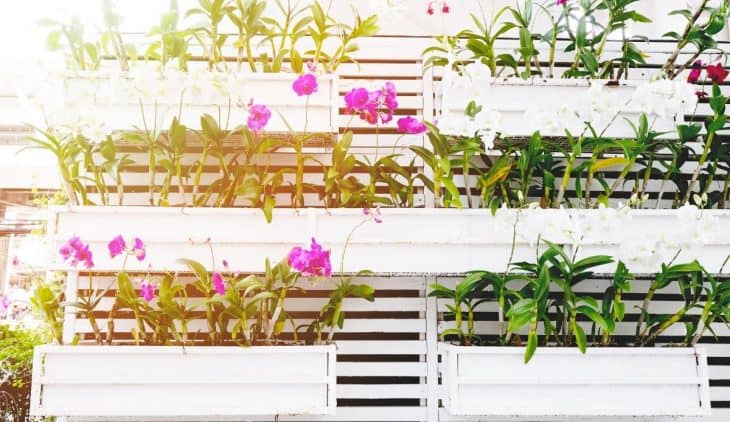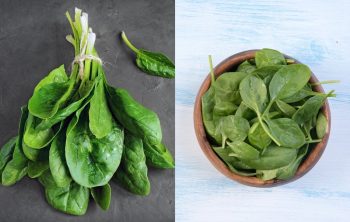Vertical gardening is an interesting type of gardening, but do you know how to set them up from the scratch? This is where vertical stackable gardening containers come in. They are popular growing tools in the techniques of indoor vertical gardeners.
Vertical gardening is a wonderful idea if you are short of grow space and you wish to maximize yield in a limited space. So, stackable gardening containers can help you achieve this and they come in different sizes and shapes to suit your plants.
In this post, we will be looking at what you need to know about vertical stackable gardening and more. So, continue reading to gain some knowledge.
What Are Stackable Garden Containers?
Stackable gardening containers are ready-made containers used in creating or setting up a vertical garden from the scratch. They are easy to set up and can be obtained online or from any garden center.
You can also make a DIY version using different materials such as woods, small plastic pots, grow bags, PVC tubes, etc. But to save yourself the stress, you should purchase a ready-made container as it will make your work easier and faster.

Guidelines On Growing With Stackable Garden Planters
For a better vertical growing experience, you need to plan and put some things into consideration before you purchase your stackable container. Below are some guidelines you can follow on growing with and choosing your stackable container:
1. Sunlight Location & Space Availability
Deciding the appropriate location for your plants to receive sunlight is one crucial factor to consider. This will determine the type of variety to grow in your vertical garden. The space available will as well determine what type of plant variety to grow.
Take for instance, when you set up your containers and your planters are too close to other vertical containers, there might be an issue with other lower container levels. The upper levels may receive more light than the lower levels which can cause the upper levels to flourish more than the lower levels. This same situation may also occur if your containers are too close to the tree or walls.
The good thing is that this can be solved by planting low light requiring plants or plants that require partial shade for the lower levels. On the other hand, you should grow plants that need full sunlight on the upper-level containers.
Plants such as vegetables and fruits will do well under full sunlight. Your plant’s label or seed packet label should contain the plant’s sun requirement. Thus, you can make a good decision with this information by matching the location you have with your planter.

2. Potting Mix To Use
The recommended potting mix to use in your vertical garden is a partially acidic garden or flowering potting mix. The potting
3. Maximum Number Of Planter Levels
The maximum number of planter levels fall between the ranges of 3 to 10. You can get some planters designs that will allow you to start with 3 to 5 levels and add up more levels with time if need be.
However, there are some downsides to stacking these containers. They can tip over if they are not rigid to the ground. But you can introduce some form of additional support to hold them down. A central rod or bar can be used to hold the container still.
Although, as the plant grows with time: the plants gain more stiffness and mass which spread across the root on each level. This may help hold the levels steady from the wind.
4. Number Of Containers Per Level
We can have the number of containers for each level to be around 3 to 6 with 4 pots. However, this can differ.
For bigger and strong plants such as strawberries, one plant per pot is recommended. But if you’re growing smaller plants such as pine berries, you can grow up to 3 or more plants in a single container. Thus, this will increase the number of plants for each container or level.
Amazing Creation Stackable Planter Vertical Garden
5. Fertilizing
The nutrient application will depend on the type of plant you have. Supply the right fertilizer quantity according to the plants’ actual needs. Also, if you notice any slight change in growth, adjust the fertilizer according to your plants’ need.
Fertilizer application will encourage strong and healthy plant growth. To your potting
6. Vertical Plant Watering
Next, we look at how to water your vertical containers. Some of these vertical container models are made using the ‘flow-through design.’ This means all you need do is to water the upper level of the container and the water will flow through and reach other levels.
You can be sure the upper level that receives most water is not totally submerged in water because the
However, with the flow-through method, ensure you monitor the lower or last level to see if water or moisture gets through to them. If they aren’t receiving moisture, this means you have to water them directly.
FAQ’s
What vegetables grow in stacked pots?
You can grow a lot of different things in a stacked pot. A good rule of thumb is that if you can plant it in the ground, it can be grown in a stacked pot. Some plants like to grow tall, some prefer shorter growth, and some grow better with an open structure. But as long as they have enough growing space, you can grow them in a stacked pot.
Stacking pots is great because it allows you to grow more than one plant at once, saving money and reducing space in your garden. It also allows you to grow more crops at once by using a vertical growing method.
How do you use stacking pots?
The first step when stacking pots is to remove all of the soil from the bottom of the pots. Remove any pots that are cracked or damaged, and make sure the potting mix is well drained. You can use a garden trowel to scrape out the mix from the bottom of the pot. Fill the bottom half of the pots with the same soil mixture as the top half. Then fill the pots with a new potting mix. For most plants, fill the pots up to two-thirds of the way with potting mix. Fill the last third with either vermiculite, peat moss, or perlite.
When it comes to planting, you want to start filling the pots with your seeds, seedlings, and cuttings. Start with the seeds and seedlings first. If you have a tray of seeds, you can put them in the middle of the pots, filling the pots halfway. Then fill the rest of the pots with the same soil mixture as the top half of the pots.
For the next step, you will need to transplant your seedlings. Take each plant out of its pot, and remove the roots from the potting mix. Place the plant into the new potting mix in the bottom half of the pot. Do not push the plant into the soil, but place the root ball gently into the new potting mix. Add some more potting mix on top of the roots until they are covered. Plants should be watered every day for the first week.
How do you choose good containers for your plants?
You can buy a variety of containers and see which ones you like. Small Medium Large
You can also purchase containers made from materials such as: Wood Porcelain Glass Stainless steel Aluminum Polyethylene Plastic
There are several things to consider when choosing a container. The first is how much space you have available.
You will want to make sure that the container you choose has enough room for your seeds to grow. If you need to grow many different varieties, you will want to look for a large container. Next, you will want to look at what type of container you would like to use. Are you planning on growing vegetables? Do you want to grow herbs? Or do you just want a container to hold some flowers? In general, you can choose between a glass, ceramic, or plastic container. Glass containers are the most common, and they are usually fairly inexpensive. Ceramic containers are also popular because they are durable and heat resistant. Plastic containers are also quite durable, but they may not be as heat resistant. You will also want to look at how much space you have available.
You should make sure that your containers have drainage holes in them, so that if there is a water problem, it will drain out instead of staying in the soil.
Conclusion On Stackable Gardening Containers
There’s no disputing that vertical gardening is a fun way of gardening and stackable gardening planters can help you achieve this. They come in different sizes and shapes which offer you the options of choosing the ones that will suit your growing plants’ needs.
Even if you live in a small spaced apartment or have just a small outdoor garden space, vertical gardening will offer you the chance of growing in any small space. So, take advantage of that small space you have in your home or garden and grow any type of crops with stackable gardening containers.

Eunice is an enthusiastic gardener with a passion for growing beautiful flowers. She loves nothing more than spending time in her garden, tending to her plants and enjoying the outdoors. Eunice has been gardening for over 15 years and has developed a unique style of landscaping that is both practical and aesthetically pleasing. She is especially fond of growing roses and enjoys experimenting with different varieties and colors. Eunice takes great pride in her garden and often shares the fruits of her labor with friends and family. In her spare time, she enjoys reading gardening magazines and attending local horticulture events. Eunice is passionate about her hobby and is always eager to share her knowledge and experience with others.





